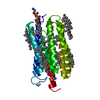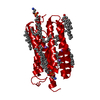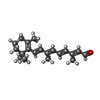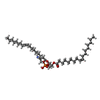[English] 日本語
 Yorodumi
Yorodumi- PDB-8gi9: Cation channelrhodopsin from Hyphochytrium catenoides (HcCCR) emb... -
+ Open data
Open data
- Basic information
Basic information
| Entry | Database: PDB / ID: 8gi9 | ||||||||||||
|---|---|---|---|---|---|---|---|---|---|---|---|---|---|
| Title | Cation channelrhodopsin from Hyphochytrium catenoides (HcCCR) embedded in peptidisc | ||||||||||||
 Components Components | Cation Channelrhodopsin | ||||||||||||
 Keywords Keywords |  TRANSPORT PROTEIN / TRANSPORT PROTEIN /  Retinal Protein / Retinal Protein /  Channelrhodopsin / Channelrhodopsin /  Cation channel / Peptidisc / Cation channel / Peptidisc /  Optogenetics Optogenetics | ||||||||||||
| Function / homology |  CHOLESTEROL / 1,2-dioleoyl-sn-glycero-3-phosphoethanolamine / CHOLESTEROL / 1,2-dioleoyl-sn-glycero-3-phosphoethanolamine /  RETINAL RETINAL Function and homology information Function and homology information | ||||||||||||
| Biological species |  Hyphochytrium catenoides (eukaryote) Hyphochytrium catenoides (eukaryote) | ||||||||||||
| Method |  ELECTRON MICROSCOPY / ELECTRON MICROSCOPY /  single particle reconstruction / single particle reconstruction /  cryo EM / Resolution: 2.84 Å cryo EM / Resolution: 2.84 Å | ||||||||||||
 Authors Authors | Morizumi, T. / Kim, K. / Li, H. / Spudich, J.L. / Ernst, O.P. | ||||||||||||
| Funding support |  Canada, 3items Canada, 3items
| ||||||||||||
 Citation Citation |  Journal: Nat Commun / Year: 2023 Journal: Nat Commun / Year: 2023Title: Structures of channelrhodopsin paralogs in peptidiscs explain their contrasting K and Na selectivities. Authors: Takefumi Morizumi / Kyumhyuk Kim / Hai Li / Elena G Govorunova / Oleg A Sineshchekov / Yumei Wang / Lei Zheng / Éva Bertalan / Ana-Nicoleta Bondar / Azam Askari / Leonid S Brown / John L ...Authors: Takefumi Morizumi / Kyumhyuk Kim / Hai Li / Elena G Govorunova / Oleg A Sineshchekov / Yumei Wang / Lei Zheng / Éva Bertalan / Ana-Nicoleta Bondar / Azam Askari / Leonid S Brown / John L Spudich / Oliver P Ernst /     Abstract: Kalium channelrhodopsin 1 from Hyphochytrium catenoides (HcKCR1) is a light-gated channel used for optogenetic silencing of mammalian neurons. It selects K over Na in the absence of the canonical ...Kalium channelrhodopsin 1 from Hyphochytrium catenoides (HcKCR1) is a light-gated channel used for optogenetic silencing of mammalian neurons. It selects K over Na in the absence of the canonical tetrameric K selectivity filter found universally in voltage- and ligand-gated channels. The genome of H. catenoides also encodes a highly homologous cation channelrhodopsin (HcCCR), a Na channel with >100-fold larger Na to K permeability ratio. Here, we use cryo-electron microscopy to determine atomic structures of these two channels embedded in peptidiscs to elucidate structural foundations of their dramatically different cation selectivity. Together with structure-guided mutagenesis, we show that K versus Na selectivity is determined at two distinct sites on the putative ion conduction pathway: in a patch of critical residues in the intracellular segment (Leu69/Phe69, Ile73/Ser73 and Asp116) and within a cluster of aromatic residues in the extracellular segment (primarily, Trp102 and Tyr222). The two filters are on the opposite sides of the photoactive site involved in channel gating. | ||||||||||||
| History |
|
- Structure visualization
Structure visualization
| Structure viewer | Molecule:  Molmil Molmil Jmol/JSmol Jmol/JSmol |
|---|
- Downloads & links
Downloads & links
- Download
Download
| PDBx/mmCIF format |  8gi9.cif.gz 8gi9.cif.gz | 81.1 KB | Display |  PDBx/mmCIF format PDBx/mmCIF format |
|---|---|---|---|---|
| PDB format |  pdb8gi9.ent.gz pdb8gi9.ent.gz | 50.8 KB | Display |  PDB format PDB format |
| PDBx/mmJSON format |  8gi9.json.gz 8gi9.json.gz | Tree view |  PDBx/mmJSON format PDBx/mmJSON format | |
| Others |  Other downloads Other downloads |
-Validation report
| Arichive directory |  https://data.pdbj.org/pub/pdb/validation_reports/gi/8gi9 https://data.pdbj.org/pub/pdb/validation_reports/gi/8gi9 ftp://data.pdbj.org/pub/pdb/validation_reports/gi/8gi9 ftp://data.pdbj.org/pub/pdb/validation_reports/gi/8gi9 | HTTPS FTP |
|---|
-Related structure data
| Related structure data |  40063MC  8gi8C M: map data used to model this data C: citing same article ( |
|---|---|
| Similar structure data | Similarity search - Function & homology  F&H Search F&H Search |
- Links
Links
- Assembly
Assembly
| Deposited unit | 
|
|---|---|
| 1 | 
|
| 2 |
|
| 3 | 
|
| Symmetry | Point symmetry: (Schoenflies symbol : C3 (3 fold cyclic : C3 (3 fold cyclic )) )) |
- Components
Components
-Protein , 1 types, 1 molecules A
| #1: Protein | Mass: 30224.213 Da / Num. of mol.: 1 Source method: isolated from a genetically manipulated source Source: (gene. exp.)  Hyphochytrium catenoides (eukaryote) / Plasmid: HcCCR_pPICZalpha-A / Production host: Hyphochytrium catenoides (eukaryote) / Plasmid: HcCCR_pPICZalpha-A / Production host:   Komagataella pastoris (fungus) / Strain (production host): SMD1168 Komagataella pastoris (fungus) / Strain (production host): SMD1168 |
|---|
-Non-polymers , 5 types, 28 molecules 








| #2: Chemical | ChemComp-RET /  Retinal Retinal | ||||||
|---|---|---|---|---|---|---|---|
| #3: Chemical | | #4: Chemical | ChemComp-CLR /  Cholesterol Cholesterol#5: Chemical |  Discrete optimized protein energy Discrete optimized protein energy#6: Water | ChemComp-HOH / |  Water Water |
-Details
| Has ligand of interest | N |
|---|
-Experimental details
-Experiment
| Experiment | Method:  ELECTRON MICROSCOPY ELECTRON MICROSCOPY |
|---|---|
| EM experiment | Aggregation state: PARTICLE / 3D reconstruction method:  single particle reconstruction single particle reconstruction |
- Sample preparation
Sample preparation
| Component | Name: Cation channelrhodopsin trimer reconstituted in peptidisc Type: COMPLEX / Entity ID: #1 / Source: RECOMBINANT | |||||||||||||||
|---|---|---|---|---|---|---|---|---|---|---|---|---|---|---|---|---|
| Molecular weight | Value: 0.030197 MDa / Experimental value: NO | |||||||||||||||
| Source (natural) | Organism:  Hyphochytrium catenoides (eukaryote) Hyphochytrium catenoides (eukaryote) | |||||||||||||||
| Source (recombinant) | Organism:   Komagataella pastoris (fungus) Komagataella pastoris (fungus) | |||||||||||||||
| Buffer solution | pH: 7.5 | |||||||||||||||
| Buffer component |
| |||||||||||||||
| Specimen | Conc.: 0.35 mg/ml / Embedding applied: NO / Shadowing applied: NO / Staining applied : NO / Vitrification applied : NO / Vitrification applied : YES / Details: Sample was kept in the dark prior to freezing. : YES / Details: Sample was kept in the dark prior to freezing. | |||||||||||||||
| Specimen support | Grid material: COPPER/RHODIUM / Grid mesh size: 400 divisions/in. / Grid type: Homemade | |||||||||||||||
Vitrification | Instrument: FEI VITROBOT MARK IV / Cryogen name: ETHANE / Humidity: 100 % / Chamber temperature: 277 K |
- Electron microscopy imaging
Electron microscopy imaging
| Experimental equipment |  Model: Titan Krios / Image courtesy: FEI Company |
|---|---|
| Microscopy | Model: FEI TITAN KRIOS |
| Electron gun | Electron source : :  FIELD EMISSION GUN / Accelerating voltage: 300 kV / Illumination mode: SPOT SCAN FIELD EMISSION GUN / Accelerating voltage: 300 kV / Illumination mode: SPOT SCAN |
| Electron lens | Mode: BRIGHT FIELD Bright-field microscopy / Nominal magnification: 75000 X / Nominal defocus max: 2400 nm / Nominal defocus min: 800 nm / Cs Bright-field microscopy / Nominal magnification: 75000 X / Nominal defocus max: 2400 nm / Nominal defocus min: 800 nm / Cs : 2.7 mm : 2.7 mm |
| Specimen holder | Cryogen: NITROGEN / Specimen holder model: FEI TITAN KRIOS AUTOGRID HOLDER |
| Image recording | Electron dose: 40 e/Å2 / Film or detector model: OTHER / Num. of grids imaged: 1 / Num. of real images: 5902 / Details: Falcon 4i detector |
| Image scans | Width: 4096 / Height: 4096 |
- Processing
Processing
| Software |
| ||||||||||||||||||||||||||||||||||||||||
|---|---|---|---|---|---|---|---|---|---|---|---|---|---|---|---|---|---|---|---|---|---|---|---|---|---|---|---|---|---|---|---|---|---|---|---|---|---|---|---|---|---|
| EM software |
| ||||||||||||||||||||||||||||||||||||||||
| Image processing | Details: Falcon 4i detector was used for collection. Images were reference corrected. | ||||||||||||||||||||||||||||||||||||||||
CTF correction | Details: CTF estimation done in cryoSPARC v4.1 / Type: PHASE FLIPPING AND AMPLITUDE CORRECTION | ||||||||||||||||||||||||||||||||||||||||
| Particle selection | Num. of particles selected: 2674318 Details: Blob picking was performed on a subset of micrographs for generating templates for template picking. | ||||||||||||||||||||||||||||||||||||||||
| Symmetry | Point symmetry : C3 (3 fold cyclic : C3 (3 fold cyclic ) ) | ||||||||||||||||||||||||||||||||||||||||
3D reconstruction | Resolution: 2.84 Å / Resolution method: FSC 0.143 CUT-OFF / Num. of particles: 298957 / Algorithm: FOURIER SPACE / Num. of class averages: 1 / Symmetry type: POINT | ||||||||||||||||||||||||||||||||||||||||
| Atomic model building | B value: 151.1 / Protocol: RIGID BODY FIT / Space: REAL / Target criteria: Cross correlation coefficent / Details: Initial fitting done in Phenix | ||||||||||||||||||||||||||||||||||||||||
| Atomic model building | Source name: AlphaFold / Type: in silico model | ||||||||||||||||||||||||||||||||||||||||
| Refinement | Cross valid method: NONE Stereochemistry target values: GeoStd + Monomer Library + CDL v1.2 | ||||||||||||||||||||||||||||||||||||||||
| Displacement parameters | Biso mean: 59.26 Å2 | ||||||||||||||||||||||||||||||||||||||||
| Refine LS restraints |
|
 Movie
Movie Controller
Controller



 PDBj
PDBj















